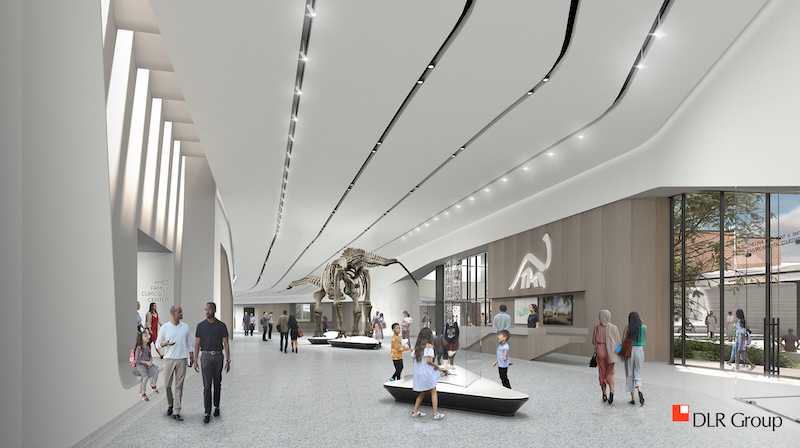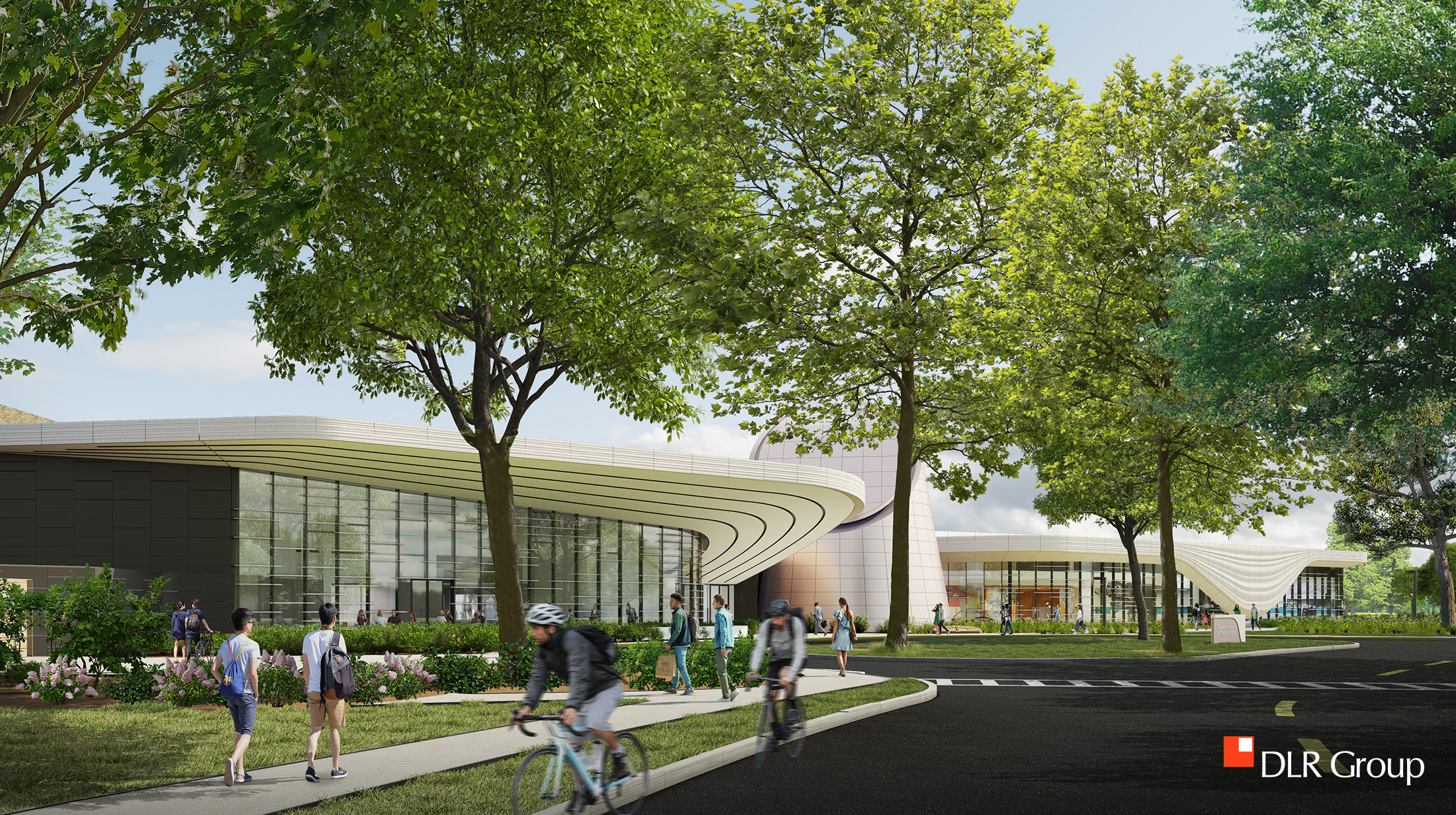Last December, the 100-year-old Cleveland Museum of Natural History completed an $8.9 million overhaul of its Thelma and Kent H. Smith Environmental Courtyard and the upgrade of its 450-seat Murch Auditorium. The courtyard was one of several “gateway” projects that have been interim stages of a $150 million expansion and renovation of the Museum, whose new 50,000-sf Exhibit Hall, main lobby, and café are scheduled to break ground this Thursday.
Sonia Winner, the Museum’s President and CEO, told the Cleveland Plain Dealer that the institution was also planning an $11.4 million upgrade of its central utility plant.
Since 1958, when the Museum moved to its current location, it has expanded at least six times. The latest expansion, designed by DLR Group, will feature a curving, snow-white roof made from cast-concrete panels and intended to evoke the glacier that covered Northeast Ohio during the last ice age. (Panzica Construction is the GC on this project.)
The museum’s latest expansion and renovation will create new exhibits, developed by Gallagher & Associates, and add curatorial posts for the purposes of connecting, in new ways, the Museum’s collections and research with public education and programming.

A rendering of the Museum's Planetary Process Gallery. The Museum's exhibit reorganization will attempt to connect humanity to the larger universe. Image: Gallagher & Associates
RETELLING HISTORY’S MARCH
The museum, which pre-pandemic was drawing 260,000 visitors annually, holds more than five million artifacts and specimens, and, through its Natural Areas program, stewards more than 11,000 acres of nature preserve in Northeast Ohio. Massive new exterior glass walls will wrap around the addition’s façade to open sightlines between the exhibits and the surrounding landscape of Wade Oval.
Inside, the traditional museum organization—by time period, geography, and species—is being deconstructed to tell integrated stories of planetary and biological processes.
The goal of this “reinvention” is to show more clearly how humanity intersects with the continuum of life on Earth and universal forces.
“We are creating a new model for natural history museums that uses the past to inform our present to build a better future together,” explains Winner. “Our reimagined museum will illuminate the interconnectedness of human life and the natural world, and how science is essential to our lives.”

An “environmental courtyard,” which received an $8.9 million makeover, now serves as one of the Museum's gateways. Image: Cleveland Museum of Natural History
EVOLUTION ON DISPLAY
The museum addition (parts of which are scheduled to open next year) is being constructed on what currently is a parking lot, and will include a central welcome and orientation area, another gateway. The new Visitors Hall will feature a reconstruction of “Lucy,” the 3.2-million-year-old human ancestor that a team of Cleveland museum scientists first discovered 45 years ago, as well as a geological sample collected from the Moon, and specimens of modern-day animals to illustrate evolutionary and biological changes.
A new self-guided interactive space, The Ames Family Curiosity Center, is meant to connect the museum’s collections with its visitors’ lived experiences and global science-related news.
The addition and renovation should be completed sometime in 2024.

Each of the Museum's exhibitions will be part of a larger evolutionary story. Image: DLR Group
Related Stories
| Dec 19, 2013
Mastering the art of crowd control and visitor flow in interpretive facilities
To say that visitor facility planning and design is challenging is an understatement. There are many factors that determine the success of a facility. Unfortunately, visitor flow, the way people move and how the facility accommodates those movements, isn’t always specifically considered.
| Dec 13, 2013
Safe and sound: 10 solutions for fire and life safety
From a dual fire-CO detector to an aspiration-sensing fire alarm, BD+C editors present a roundup of new fire and life safety products and technologies.
| Dec 10, 2013
16 great solutions for architects, engineers, and contractors
From a crowd-funded smart shovel to a why-didn’t-someone-do-this-sooner scheme for managing traffic in public restrooms, these ideas are noteworthy for creative problem-solving. Here are some of the most intriguing innovations the BD+C community has brought to our attention this year.
| Nov 27, 2013
BIG's 'oil and vinegar' design wins competition for the Museum of the Human Body [slideshow]
The winning submission by Bjarke Ingels Group (BIG) and A+ Architecture mixes urban pavement and parkland in a flowing, organic plan, like oil and vinegar, explains Bjarke Ingels.
| Nov 27, 2013
Wonder walls: 13 choices for the building envelope
BD+C editors present a roundup of the latest technologies and applications in exterior wall systems, from a tapered metal wall installation in Oklahoma to a textured precast concrete solution in North Carolina.
| Nov 26, 2013
Construction costs rise for 22nd straight month in November
Construction costs in North America rose for the 22nd consecutive month in November as labor costs continued to increase, amid growing industry concern over the tight availability of skilled workers.
| Nov 25, 2013
Building Teams need to help owners avoid 'operational stray'
"Operational stray" occurs when a building’s MEP systems don’t work the way they should. Even the most well-designed and constructed building can stray from perfection—and that can cost the owner a ton in unnecessary utility costs. But help is on the way.
| Nov 19, 2013
Top 10 green building products for 2014
Assa Abloy's power-over-ethernet access-control locks and Schüco's retrofit façade system are among the products to make BuildingGreen Inc.'s annual Top-10 Green Building Products list.
| Nov 13, 2013
Installed capacity of geothermal heat pumps to grow by 150% by 2020, says study
The worldwide installed capacity of GHP systems will reach 127.4 gigawatts-thermal over the next seven years, growth of nearly 150%, according to a recent report from Navigant Research.
| Nov 13, 2013
First look: Renzo Piano's addition to Louis Kahn's Kimbell Art Museum [slideshow]
The $135 million, 101,130-sf colonnaded pavilion by the famed architect opens later this month.

















